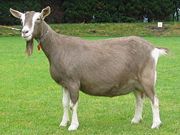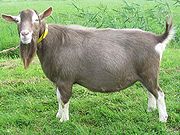
Toggenburg (goat)
Encyclopedia


Goat
The domestic goat is a subspecies of goat domesticated from the wild goat of southwest Asia and Eastern Europe. The goat is a member of the Bovidae family and is closely related to the sheep as both are in the goat-antelope subfamily Caprinae. There are over three hundred distinct breeds of...
, named after the region in Switzerland
Switzerland
Switzerland name of one of the Swiss cantons. ; ; ; or ), in its full name the Swiss Confederation , is a federal republic consisting of 26 cantons, with Bern as the seat of the federal authorities. The country is situated in Western Europe,Or Central Europe depending on the definition....
where the breed originated, the Toggenburg valley. Toggenburgs are medium in size, moderate in production, and have relatively low butterfat
Butterfat
Butterfat or milkfat is the fatty portion of milk. Milk and cream are often sold according to the amount of butterfat they contain.- Composition :The fatty acids of butterfat are typically composed as follows :...
content (2-3%) in their milk. Toggenburgs possess a general Swiss Marked
Swiss Marked
Goats expressing the Swiss Marked pattern have a black body and belly and tan legs, ears, and facial stripes. The allele which codes for this pattern is located at the agouti locus of the goat genome...
pattern with various dilutions. The color is solid varying from light fawn to dark chocolate, with no preference for any shade. Distinct white markings are as follows: white ears with dark spot in middle; two white stripes down the face from above each eye to the muzzle; hind legs white from hocks to hooves; forelegs white from knees downward with a dark line (band) below knee acceptable; a white triangle on either side of the tail. Wattles, small rudimentary nubs of skin located on each side of the neck, are often present in this breed. The Toggenburg breed underwent a development program when introduced to Britain; the resulting British Toggenburgs are heavier and have improved milk quality. By the middle of 2002, 4146 Toggenburgs had been registered with the New Zealand Dairy Goat Breeders Association, representing 8.10% of registered dairy goats. They perform better in cooler conditions. They are the oldest known dairy breed of goats.
Toggenburgs should have compact bodies, and does should have high, well-attached udders. They should have straight or dished faces, but never roman noses. Toggenburgs are generally a friendly, quiet and gentle breed, and are good as pets.

